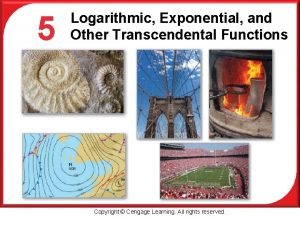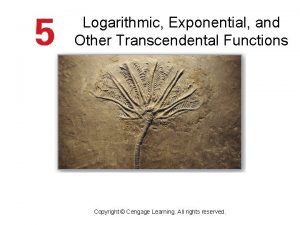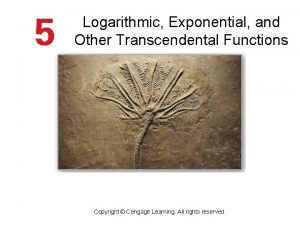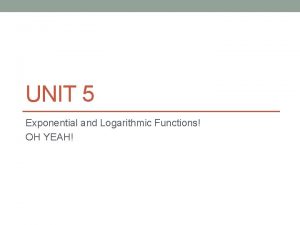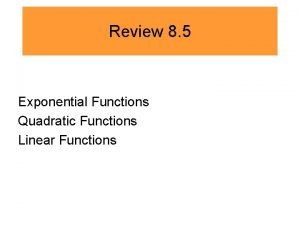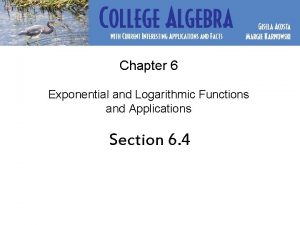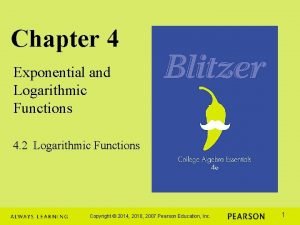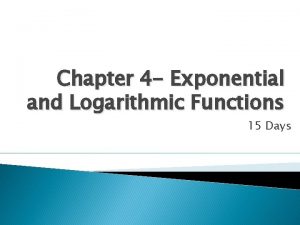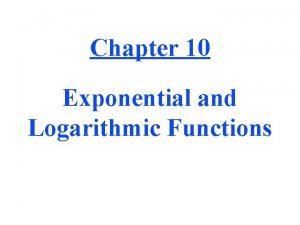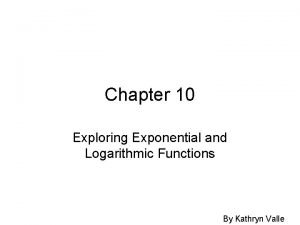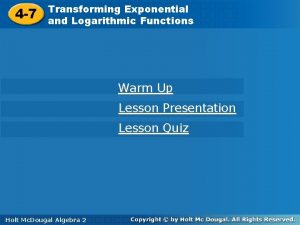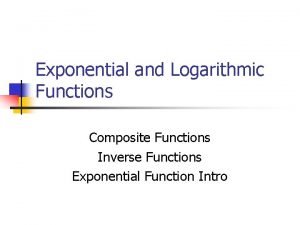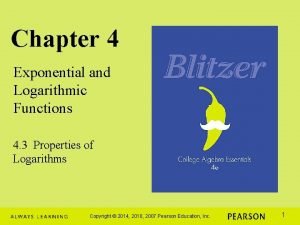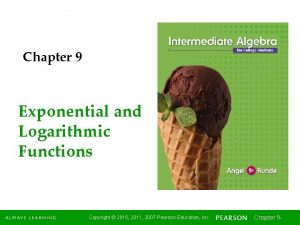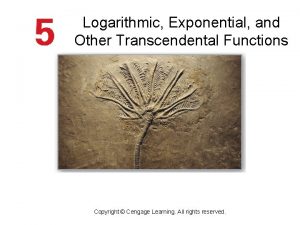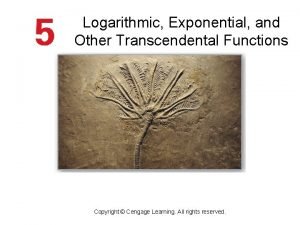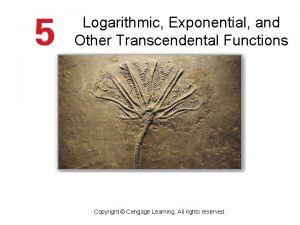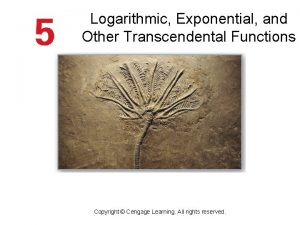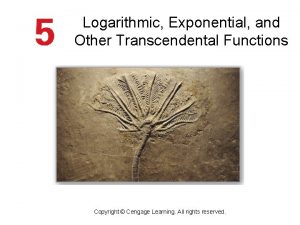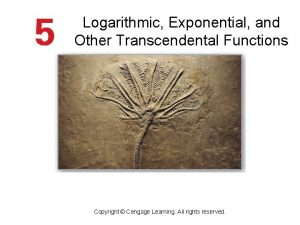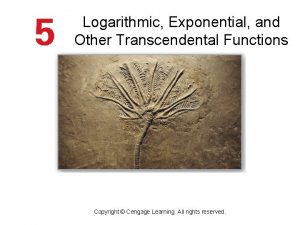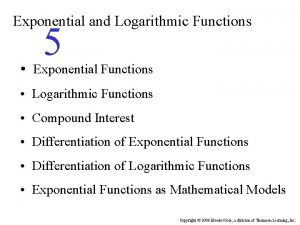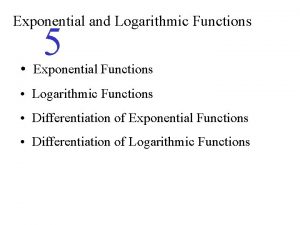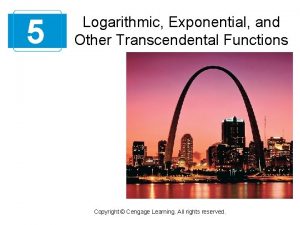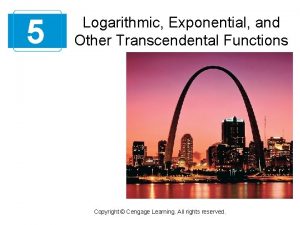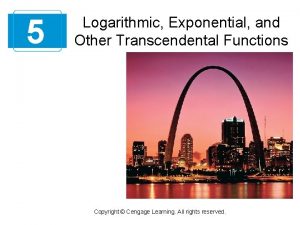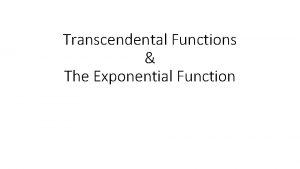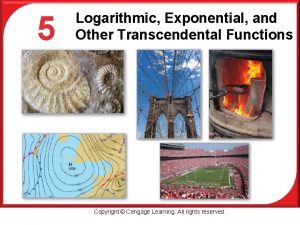Logarithmic Exponential and Other Transcendental Functions Copyright Cengage



















- Slides: 19

Logarithmic, Exponential, and Other Transcendental Functions Copyright © Cengage Learning. All rights reserved.

Exponential Functions: Differentiation and Integration Copyright © Cengage Learning. All rights reserved.

Objectives n Develop properties of the natural exponential function. n Differentiate natural exponential functions. n Integrate natural exponential functions. 3

The Natural Exponential Function 4

The Natural Exponential Function The function f(x) = ln x is increasing on its entire domain, and therefore it has an inverse function f – 1. The domain of f – 1 is the set of all reals, and the range is the set of positive reals, as shown in Figure 5. 19 5

The Natural Exponential Function So, for any real number x, If x happens to be rational, then Because the natural logarithmic function is one-to-one, you can conclude that f – 1(x) and ex agree for rational values of x. 6

The Natural Exponential Function The following definition extends the meaning of ex to include all real values of x. The inverse relationship between the natural logarithmic function and the natural exponential function can be summarized as follows. 7

Example 1 – Solving Exponential Equations Solve 7 = ex + 1. Solution: You can convert from exponential form to logarithmic form by taking the natural logarithm of each side of the equation. So, the solution is – 1 + ln 7 ≈ – 0. 946. You can check this solution as shown. 8

Example 1 – Solving Exponential Equations Solve 7 = ex + 1. Solution: You can convert from exponential form to logarithmic form by taking the natural logarithm of each side of the equation. So, the solution is – 1 + ln 7 ≈ – 0. 946. 9

Example 1 – Solution (cont) You can check this solution as shown. 10

The Natural Exponential Function The familiar rules for operating with rational exponents can be extended to the natural exponential function, as shown in the next theorem. 11

The Natural Exponential Function An inverse function f – 1 shares many properties with f. So, the natural exponential function inherits the following properties from the natural logarithmic function. 12

The Natural Exponential Function 13

Derivatives of Exponential Functions 14

Derivatives of Exponential Functions One of the most intriguing (and useful) characteristics of the natural exponential function is that it is its own derivative. In other words, it is a solution to the differential equation y' = y. This result is stated in the next theorem. 15

Example 3 – Differentiating Exponential Functions Find the derivative of each function. a. y = e 2 x-1 b. y = e-3/x Solution: 16

Integrals of Exponential Functions 17

Integrals of Exponential Functions Each differentiation formula in Theorem 5. 11 has a corresponding integration formula. 18

Example 7 – Integrating Exponential Functions Find the indefinite integral. Solution: If you let u = 3 x + 1, then du = 3 dx 19
 Horizontal line test inverse
Horizontal line test inverse Chapter 5 logarithmic exponential and other
Chapter 5 logarithmic exponential and other Logarithmic exponential and other transcendental functions
Logarithmic exponential and other transcendental functions Unit 8 exponential and logarithmic functions
Unit 8 exponential and logarithmic functions Unit 5: exponential and logarithmic functions answers
Unit 5: exponential and logarithmic functions answers Quadratic table
Quadratic table Chapter 6 exponential and logarithmic functions answers
Chapter 6 exponential and logarithmic functions answers Chapter 4 exponential and logarithmic functions
Chapter 4 exponential and logarithmic functions Chapter 4 exponential and logarithmic functions
Chapter 4 exponential and logarithmic functions Pert formula
Pert formula Chapter 5 exponential and logarithmic functions answers
Chapter 5 exponential and logarithmic functions answers Transforming exponential and logarithmic functions
Transforming exponential and logarithmic functions Inverse functions logarithmic and exponential
Inverse functions logarithmic and exponential Lesson 5-2
Lesson 5-2 Expanding logarithmic functions
Expanding logarithmic functions Chapter 9 exponential and logarithmic functions answer key
Chapter 9 exponential and logarithmic functions answer key Chapter 9 exponential and logarithmic functions answer key
Chapter 9 exponential and logarithmic functions answer key Chapter 5 exponential and logarithmic functions answer key
Chapter 5 exponential and logarithmic functions answer key Solving exponential and logarithmic functions calculator
Solving exponential and logarithmic functions calculator Chapter 5 exponential and logarithmic functions
Chapter 5 exponential and logarithmic functions
